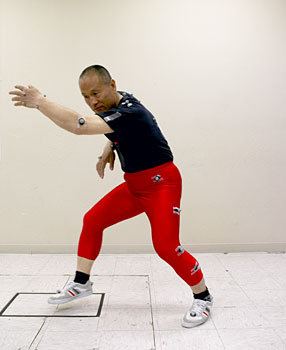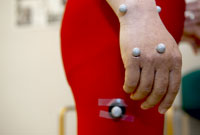SUMMER 2008 CONTENTS
Home
Good as Gold?
New drug approvals ebb; doubts over testing's gold standard grow
Q&A with Katie Couric
Standing up for cancer research
Breath of Hope
Lifeline or gamble? Sometimes a clinical trial is both
Just Another Lab Rat
The human subjects trade is booming, largely without oversight
Fixing Trial Tribulations
Solutions from Stanford
A Spoonful of Sugar Pills
Why nothing really is something, and in some ways is better than anything
Banding Together
Minds of all kinds join to hasten discoveries of new medical treatments


Chi Whiz
The Science of a Tai Chi Strike
By Krista Conger
Photos by Steve Gladfelter/Stanford Visual Art Services
Chen Xiang does 0 to 60 mph in less than three seconds. Well, at least his arm does.
One of the world’s most accomplished tai chi practitioners, Chen had his moves analyzed at Lucile Packard Children’s Hospital’s Motion & Gait Analysis Laboratory in April.
“Tai chi represents optimal body movement, honed over centuries,” says Jessica Rose, PhD, who directs the lab’s efforts to help children with cerebral palsy and other movement disorders. “It seems to be an almost perfect example of translating the angular momentum of his body into the linear momentum of the strike,” says Rose. “The power begins first in the trailing foot, is rotated through the body in a super-fast pivot, then transferred to the striking arm.”
At full strength, the blow delivered a floor reaction torque, or twisting force against the floor, of more than 14 times Chen’s body weight; his arm accelerated to 60 miles per hour within three seconds. The researchers also used thermography and functional magnetic resonance imaging to measure biophysical changes that occur during the process of “focusing the chi.”
Reflective markers track tai chi master Chen Xiang’s movements.
In Chinese martial arts and Eastern medicine, chi represents a life force that can be focused through meditative concentration.
Last year, a study with Stanford’s resident tai chi master, Shu Dong Li, showed he could warm or cool his hands several degrees at will. And focusing the chi in this way corresponded with brain activation in areas associated with movement and feeling in the hands.
Might harnessing this ability help manage disease or reduce stress? Recent studies from other institutions have suggested that tai chi training can promote calmness and relaxation in middle school children and improve pulmonary function in children with asthma. Adult practitioners gain balance, musculoskeletal, cardiovascular and immune benefits.
So in April, researchers from Packard Children’s and the university’s departments of orthopedic surgery, radiology, biology and computer sciences teamed up to conduct similar tests on Chen, who teaches in Beijing. They are now analyzing the results.
Rose hopes their studies of the master at work will advance understanding of motor deficits, robotics and rehabilitation-device design for children for whom simply walking across the floor is a struggle. As for Chen, he’s especially curious whether Western medicine can define chi.


